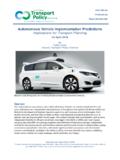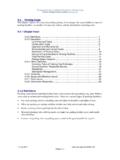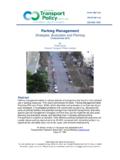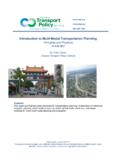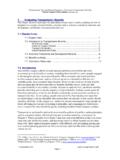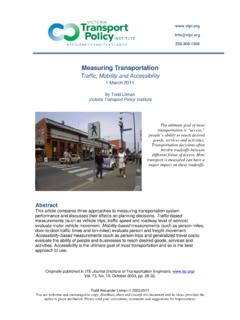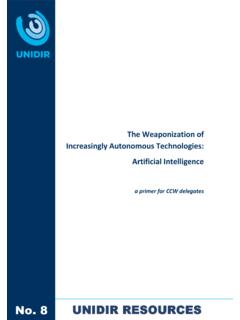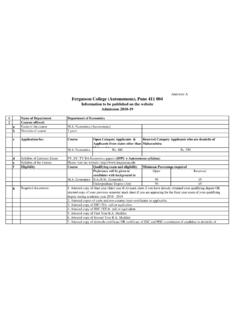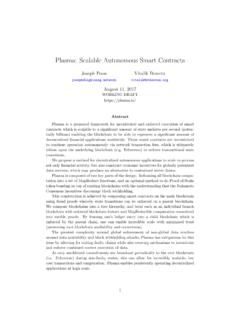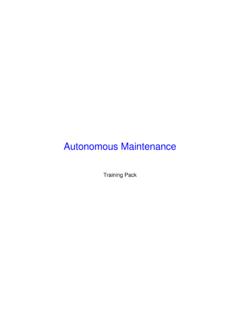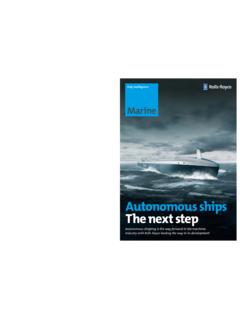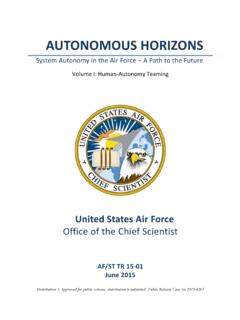Transcription of Autonomous Vehicle Implementation Predictions - vtpi.org
1 Phone 250-360-1560. Autonomous Vehicle Implementation Predictions Implications for Transport Planning 24 April 2018. By Todd Litman Victoria Transport Policy Institute Waymo's self-driving taxis are a well-publicized example of Autonomous vehicles. Abstract This report explores Autonomous (also called self-driving, driverless or robotic) Vehicle benefits and costs, and impacts on transportation planning issues. It investigates how quickly self-driving vehicles are likely to be developed and deployed based on experience with previous Vehicle technologies, their benefits and costs, and how they are likely to affect travel demands and planning decisions such as optimal road, parking and public transit supply. This analysis indicates that some benefits, such as more independent mobility for affluent non-drivers, may begin in the 2020s or 2030s, but most impacts, including reduced traffic and parking congestion (and therefore infrastructure savings), independent mobility for low-income people (and therefore reduced need for public transit), increased safety, energy conservation and pollution reductions, will only be significant when Autonomous vehicles become common and affordable, probably in the 2040s to 2050s, and some benefits may require prohibiting human-driven vehicles on certain roadways, which could take even longer.
2 Todd Alexander Litman 2013-2018. You are welcome and encouraged to copy, distribute, share and excerpt this document and its ideas, provided the author is given attribution. Please send your corrections, comments and suggestions for improvement. Autonomous Vehicle Implementation Predictions : Implications for Transport Planning Victoria Transport Policy Institute Table of Contents Introduction .. 3. Autonomous Vehicle Operational Models .. 4. Benefits and 5. Reduced Stress, Improved Productivity and Mobility .. 5. Ownership and Operating Costs .. 7. Traffic Safety .. 10. External Cost .. 11. Benefit and Cost Summary .. 12. Development and 13. Experience with Previous Vehicle Technology Deployment .. 15. Deployment Predictions .. 17. Travel Impacts .. 18. Potential Conflicts and Solutions .. 23. Planning Implications .. 24. Conclusions.
3 28. References .. 30. 2. Autonomous Vehicle Implementation Predictions : Implications for Transport Planning Victoria Transport Policy Institute Introduction The future is ultimately unknowable, yet planning requires Predictions of future needs. Many decision-makers and practitioners (planners, engineers and analysts) wonder how Autonomous (also called self-driving or robotic) vehicles will affect future travel demands, how this should affect planning for roads, parking and public transit systems, and whether policies should encourage or restrict their use (APA 2016; Grush 2016; Guerra 2015; Kockelman, et al. 2016;. Levinson 2015; Milakis, van Arem and van Wee 2017). There is considerable uncertainty about these factors. Some advocates predict that by 2030, Autonomous vehicles will be sufficiently convenient and affordable to displace most human- operated vehicles, will provide independent mobility to non-drivers, reduce the stress and tedium of driving, and be a panacea for congestion, accident and pollution problems (Johnston and Walker 2017; Keeney 2017; Kok, et al.)
4 2017), but there are good reasons to be skeptical of such optimistic claims. Most optimistic Predictions are made by people with financial interests in the industry, based on experience with electronic innovations such as digital cameras, smart phones and the Internet. Their analysis often overlooks significant Implementation requirements and costs. Although vehicles can now operate autonomously under certain conditions, many technical problems must be solved before they can operate autonomously under all normal conditions, and many years before such vehicles are adequately tested, approved for general commercial sale, and affordable to most travellers. Motor vehicles last much longer and cost much more than personal computers, cameras or telephones, so new technologies generally require many years to penetrate Vehicle fleets. System failures by camera, telephones and the Internet can be frustrating but are seldom fatal; system failures by motor vehicles can be frustrating and deadly to occupants and other road users.
5 Autonomous driving can induce additional Vehicle travel which can increase traffic problems. As a result, Autonomous vehicles are likely take longer to develop and provide smaller net benefits than optimists predict. These factors have significant transport policy and planning implications (Papa and Ferreira 2018; Speck 2017). Vehicles rely on public infrastructure and impose external costs, and so require more public planning and investment than most other technologies. For example, Autonomous vehicles can be programed based on user preferences (maximizing traffic speeds and occupant safety) or community goals (limiting speeds and protecting other road users), and many predicted Autonomous Vehicle benefits, including congestion and pollution reductions, require dedicated lanes to allow platooning (numerous vehicles driving close together at relatively high speeds).
6 Policy makers must decide how to regulate and price Autonomous driving, and when potential benefits justify dedicating traffic lanes to their exclusive use. This report explores these issues. It investigates, based on experience with previous Vehicle technologies, how quickly self-driving vehicles are likely to be developed and deployed, critically evaluates their likely benefits and costs, and discusses their likely travel impacts and their implications for planning decisions such as optimal road, parking and public transit supply. 3. Autonomous Vehicle Implementation Predictions : Implications for Transport Planning Victoria Transport Policy Institute Autonomous Vehicle Operational Models The Society of Automobile Engineers (SAE) defined five levels of Autonomous driving, as summarized in Exhibit 1. Levels 1-3 require a licensed driver, but levels 4 and 5 allow driverless operation, which is necessary for many predicted benefits.
7 Exhibit 1 Automated Driving Levels (SAE 2014). The SAE defined five Vehicle automation levels. Most predicted benefits require levels 4 or 5. Exhibit 2 summarizes three Autonomous Vehicle operational models. Table 2 Autonomous Vehicle Operational Models Compared Advantages Disadvantages Appropriate Users High convenience. Available High costs. Does not allow People who travel a lot, Personal Autonomous without delay. Items, such users to choose different reside in sprawled areas, vehicles - Motorists own as equipment, tools and vehicles for different trips, want a particular Vehicle , or lease their own self- snacks, can be left in such as cars for commuting or or leave items in their driving vehicles vehicles. trucks for errands. vehicles. Users must wait for vehicles. Shared Autonomous Limited service (no driver to vehicles - Self-driving taxis Users can choose vehicles help passengers carry luggage transport individuals and that best meet their needs.)
8 Safely reach their door). Lower-annual-mileage groups to destinations. Door to door service. Vehicles may be dirty. users. Shared Autonomous rides - Self-driving vans (micro- Least convenience, comfort transit) take passengers to and speed, particularly in Lower-income urban or near destinations. Lowest costs. sprawled areas. residents. Autonomous vehicles can be personal or shared. Each model has advantages and disadvantages. 4. Autonomous Vehicle Implementation Predictions : Implications for Transport Planning Victoria Transport Policy Institute Benefits and Costs Autonomous vehicles can provide various benefits and impose various costs. Reduced Stress, Improved Productivity and Mobility Autonomous vehicles can reduce driver stress and tedium. Self-driving cars can be mobile bedrooms, playrooms and offices, as illustrated below, allowing passengers to rest or be productive while travelling (WSJ 2017).
9 This can reduce travel time unit costs (dollars per hour). Exhibit 3 Productivity and Relaxation While Travelling Self-driving cars can be mobile bedrooms, playrooms or offices, allowing travellers to rest and be productive. On the other hand, self-driving vehicles can introduce new stresses and discomforts. Grush (2016) suggests that travellers will experience access anxiety, if they fear that their Vehicle cannot reach a desired destination. To minimize cleaning and vandalism costs, self-driving taxis and buses will have hardened interiors (vinyl seats and stainless steel surfaces), minimal accessories, and security cameras. Demand response ridesharing (vehicles with flexible routes to pick up and drop off passengers at or near their destinations) will reduce security (passengers may need to share space with strangers), and reduce travel speed and reliability since each additional pick-up or drop-off will impose a few minutes of delay to other passengers, particularly in sprawled areas with dead-end streets.
10 Autonomous vehicles can provide independent mobility for non-drivers, including people with disabilities, adolescents, and others or who for any reason cannot or should not drive. This can provide direct benefits to those travellers, reduce chauffeuring burdens on their family members and friends, and in some cases increase their access to education and employment opportunities, increasing their economic productivity. Some affluent non-drivers living in sprawled areas may purchase personal Autonomous vehicles, and urban non-drivers are likely to use Autonomous taxies. Optimistic Predictions of Autonomous Vehicle benefits may cause some communities to reduce support for public transit services which may reduce mobility options for non-drivers. Dedicating highway lanes for Autonomous Vehicle platooning may reduce capacity for human- operated traffic, making travellers in human-operated vehicles worse off.
